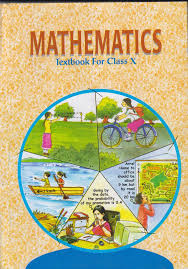Class 10 - Mathematics
Linear Equations In Two Variables - Exercise 3.6

Top Block 1
Exercise 3.6
Question : 1:Solve the following pairs of equations by reducing them to a pair of linear equations:
(i) 1/2x + 1/3y = 2 (ii) 2/√x + 3/√y = 2
1/3x + 1/2y = 13/6 4/√x – 9/√y = -1
(iii) 4/x + 3y = 14 (iv) 5/(x – 1) + 1/(y – 2) = 2
3/x – 4y = 23 6/(x – 1) – 3/(y – 2) = 1
(v) (7x – 2y)/xy = 5 (vi) 6x + 3y = 6xy
(8x + 7y)/xy = 15 2x + 4y = 5xy
(vii) 10/(x + y) + 2/(x – y) = 4 (viii) 1/(3x + y) + 1/(3x – y) = 3/4
15/(x + y) – 5/(x – y) = -2 1/2(3x + y) – 1/2(3x – y) = -1/8
Answer :
(i) 1/2x + 1/3y = 2
1/3x + 1/2y = 13/6
Let 1/x = p and 1/y = q, then the equations changes as below:
p/2 + q/3 = 2
3p + 2q – 12 = 0 … (i)
p/3 + q/2 = 13/6
2p + 3q – 13 = 0 … (ii)
By cross-multiplication method, we get
p/{–26 – (–36)} = q/{–24 – (–39)} = 1/{9 – 4}
p/10 = q/15 = 1/5
p/10 = 1/5 and q/15 = 1/5
p = 2 and q = 3
1/x = 2 and 1/y = 3
Hence, x = 1/2 and y = 1/3
(ii) 2/√x + 3/√y = 2
4/√x + 9/√y = -1
Let 1/√x = p and 1/√y = q, then the equation changes as below:
2p + 3q = 2 … (i)
4p – 9q = – 1 … (ii)
Multiplying equation (i) by 3, we get
6p + 9q = 6 … (iii)
Adding equation (ii) and (iii), we get
10p = 5
p = 1/2 … (iv)
Putting value of P in equation (i), we get
2 * 1/2 + 3q = 2
3q = 1
q = 1/3
p = 1/√x = 1/2
√x = 2
x = 4 and
q = 1/√y = 1/3
√y = 3
y = 9
Hence, x = 4, y = 9
(iii) 4/x + 3y = 14
3/x – 4y = 23
Putting 1/x = p in the given equations, we get
4p + 3y = 14
⇒ 4p + 3y – 14 = 0
3p – 4y = 23
⇒ 3p – 4y – 23 = 0
By cross-multiplication, we get
p/{–69 – 56} = y/{–42 – (–92)} = 1/{–16 – 9}
⇒ -p/125 = y/50 = – 1/25
Now, -p/125 = – 1/25 and y/50 = – 1/25
⇒ p = 5 and y = – 2
Also, p = 1/x = 5
⇒ x = 1/5
So, x = 1/5 and y = – 2 is the solution.
(v) 5/(x – 1) + 1/(y – 2) = 2
6/(x – 1) – 3/(y – 2) = 1
Putting 1/(x – 1) = p and 1/(y – 2) = q in the given equations, we obtain
5p + q = 2 … (i)
6p – 3q = 1 … (ii)
Now, by multiplying equation (i) by 3 we get
15p + 3q = 6 … (iii)
Now, adding equation (ii) and (iii)
21p = 7
⇒ p = 1/3
Putting this value in equation (ii) we get,
6 * 1/3 – 3q =1
⇒ 2 – 3q = 1
⇒ – 3q = 1 – 2
⇒– 3q = – 1
⇒ q = 1/3
Now,
p = 1/(x – 1) = 1/3
⇒ 1/(x – 1) = 1/3
⇒ 3 = x – 1
⇒ x = 4
Also,
q = 1/(y – 2) = 1/3
⇒ 1/(y – 2) = 1/3
⇒ 3 = y – 2
⇒ y = 5
Hence, x = 4 and y = 5 is the solution.
(v) (7x – 2y)/xy = 5
⇒ 7x/xy – 2y/xy = 5
⇒ 7/y – 2/x = 5 … (i)
(8x + 7y)/xy = 15
⇒ 8x/xy + 7y/xy = 15
⇒ 8/y + 7/x = 15 … (ii)
Putting 1/x = p and 1/y = q in (i) and (ii) we get,
7q – 2p = 5 … (iii)
8q + 7p = 15 … (iv)
Multiplying equation (iii) by 7 and multiplying equation (iv) by 2 we get,
49q – 14p = 35 … (v)
16q + 14p = 30 … (vi)
Now, adding equation (v) and (vi) we get,
49q – 14p + 16q + 14p = 35 + 30
⇒ 65q = 65
⇒ q = 1
Putting the value of q in equation (iv)
8 + 7p = 15
⇒ 7p = 7
⇒ p = 1
Now,
p = 1/x = 1
⇒ 1/x = 1
⇒ x = 1
also, q = 1 = 1/y
⇒ 1/y = 1
⇒ y = 1
Hence, x =1 and y = 1 is the solution.
(vi) 6x + 3y = 6xy
⇒ 6x/xy + 3y/xy = 6
⇒ 6/y + 3/x = 6 … (i)
2x + 4y = 5xy
⇒ 2x/xy + 4y/xy = 5
⇒ 2/y + 4/x = 5 … (ii)
Putting 1/x = p and 1/y = q in (i) and (ii) we get,
6q + 3p – 6 = 0
2q + 4p – 5 = 0
By cross multiplication method, we get
p/{–30 – (–12)} = q/{–24 – (–15)} = 1/{6 – 24)
p/(–18) = q/(–9) = 1/(–18)
p/(–18) = 1/(–18) and q/(–9) = 1/(–18)
p = 1 and q = 1/2
p = 1/x = 1 and q = 1/y = 1/2
x = 1, y = 2
Hence, x = 1 and y = 2
(vii) 10/(x + y) + 2/(x – y) = 4
15/(x + y) – 5/(x – y) = – 2
Putting 1/(x + y) = p and 1/(x – y) = q in the given equations, we get:
10p + 2q = 4
⇒ 10p + 2q – 4 = 0 … (i)
15p – 5q = – 2
⇒ 15p – 5q + 2 = 0 … (ii)
Using cross multiplication, we get
p/(4 – 20) = q/{–60 – (–20)} = 1/(–50 – 30)
p/(–16) = q/(–80) = 1/(–80)
p/(–16) = 1/(–80) and q/(–80) = 1/(–80)
p = 1/5 and q = 1
p = 1/(x + y) = 1/5 and q = 1/(x – y) = 1
x + y = 5 … (iii)
and x – y = 1 … (iv)
Adding equation (iii) and (iv), we get
2x = 6
x = 3 …. (v)
Putting value of x in equation (iii), we get
y = 2
Hence, x = 3 and y = 2
(viii) 1/(3x + y) + 1/(3x – y) = 3/4
1/2(3x – y) – 1/2(3x – y) = – 1/8
Putting 1/(3x + y) = p and 1/(3x – y) = q in the given equations, we get
p + q = 3/4 … (i)
p/2 – q/2 = – 1/8
p – q = – 1/4 … (ii)
Adding equation (i) and (ii), we get
2p = 3/4 – 1/4
2p = 1/2
p = 1/4
Putting the value in equation (ii), we get
1/4 – q = – 1/4
q = 1/4 + 1/4 = 1/2
p = 1/(3x + y) = 1/4
3x + y = 4 … (iii)
q = 1/(3x – y) = 1/2
3x – y = 2 … (iv)
Adding equations (iii) and (iv), we get
6x = 6
x = 1 … (v)
Putting the value in equation (iii), we get
3(1) + y = 4
y = 1
Hence, x = 1 and y = 1
Mddle block 1
Question : 2:Formulate the following problems as a pair of equations, and hence find their solutions:
(i) Ritu can row downstream 20 km in 2 hours, and upstream 4 km in 2 hours. Find her speed of rowing in still water and the speed of the current.
(ii) 2 women and 5 men can together finish an embroidery work in 4 days, while 3 women and 6 men can finish it in 3 days.
Find the time taken by 1 woman alone to finish the work, and also that taken by 1 man alone.
(iii) Roohi travels 300 km to her home partly by train and partly by bus. She takes 4 hours if she travels 60 km by train and the remaining by bus.
If she travels 100 km by train and the remaining by bus, she takes 10 minutes longer. Find the speed of the train and the bus separately.
Answer :
Let the speed of Ritu in still water and the speed of stream be x km/h and y km/h respectively.
Speed of Ritu while rowing
Upstream = (x – y) km/h
Downstream = (x + y) km/h
According to question,
2(x + y) = 20
⇒ x + y = 10 … (i)
2(x – y) = 4
⇒ x – y = 2 … (ii)
Adding equation (i) and (ii), we get
Putting this equation in (i), we get
y = 4
Hence, Ritu’s speed in still water is 6 km/h and the speed of the current is 4 km/h.
(ii) Let the number of days taken by a woman and a man be x and y respectively.
Therefore, work done by a woman in 1 day = 1/x
According to the question,
4(2/x + 5/y) = 1
2/x + 5/y = 1/4
3(3/x + 6/y) = 1
3/x + 6/y = 1/3
Putting 1/x = p and 1/y = q in these equations, we get
2p + 5q = 1/4
By cross multiplication, we get
p/{–20 – (–18)} = q/{–9 – (–18)} = 1/(144 – 180)
p/(–2) = q/(–1) = 1/(–36)
p/(–2) = -1/36 and q/(–1) = 1/(–36)
p = 1/18 and q = 1/36
p = 1/x = 1/18 and q = 1/y = 1/36
x = 18 and y = 36
Hence, number of days taken by a woman = 18 and number of days taken by a man = 36
(iii) Let the speed of train and bus be u km/h and v km/h respectively.
According to the given information,
60/u + 240/v = 4 … (i)
100/u + 200/v = 25/6 … (ii)
Putting 1/u = p and 1/v = q in the equations, we get
60p + 240q = 4 … (iii)
100p + 200q = 25/6
600p + 1200q = 25 … (iv)
Multiplying equation (iii) by 10, we get
600p + 2400q = 40 …. (v)
Subtracting equation (iv) from (v), we get
1200q = 15
q = 15/200 = 1/80 … (vi)
Putting equation (iii), we get
60p + 3 = 4
60p = 1
p = 1/60
p = 1/u = 1/60 and q = 1/v = 1/80
u = 60 and v = 80
Hence, speed of train = 60 km/h and speed of bus = 80 km/h.

